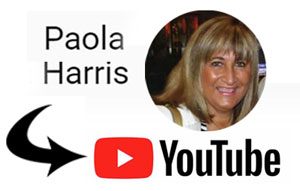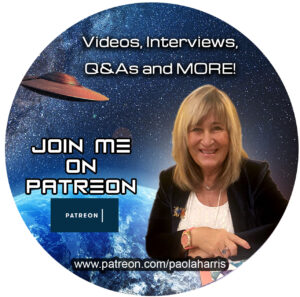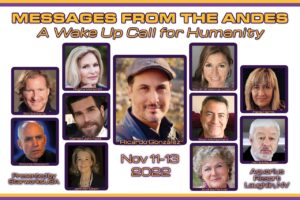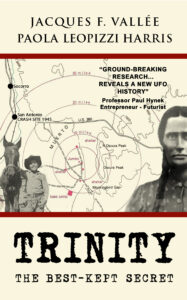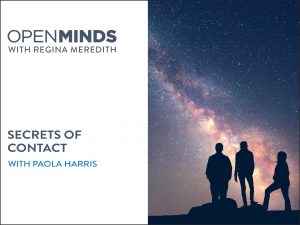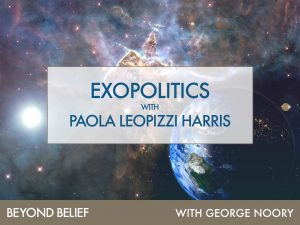A Tale of two Urchins:
Truth and Consequences in New Mexico Ufology
Jacques Vallée — 23 September 2023
——————–
In a recent post, appended to his widely distributed blog that reports on legislative and other government events in Washington, DC, Mr. Dale Johnson has taken me to task, along with my co-author Paola Harris, for biased reporting on a UFO crash that took place in 1945 just outside the New Mexico atomic site where the first nuclear bomb had been “tested” (i.e., exploded) just a month earlier. Our book, entitled “Trinity–the best-kept secret” is not concerned with that case alone, but it re-investigates a pattern among three prominent UFO landings, with new, previously unpublished information on all three events. The cases are Trinity, Socorro and Valensole in France. The last two are carried as “unidentified” by the respective governments of the US and France, after very extensive physical study. I have been closely involved in the research about all three cases.
In his attacks against the book, Mr. Johnson does not address the patterns we discovered within this trilogy. We have shown that the Trinity crash, two years before Roswell, involved the same type of occupants later seen at Valensole and Socorro, (under 5 feet tall, with humanoid facial features, and breathing our air), the same type of craft in sizes and weights, and the same displays in modes of propulsion, a remarkable pattern that scientists could extend to other cases such as Roswell in New Mexico or more recent cases in Latin America or even Russia.
This brings up the first remark about the way Mr. Johnson approached our investigation: not as a scientist, as he promoted himself in his critique, but as a skilled prosecutor who attempts to select weak points in the record, ignoring the rest to cast doubt not only on the accuracy of the research presented, but on the competency and, by implication, the honesty of our investigation. Also ignored is the fact that two children in a remote part of New Mexico could not have anticipated the fundamental features of the officially recognized, unexplained crashes that followed.
A scientist approaching our subject (like the experts who did study the site and the witnesses on the record, at our invitation) would have acted very differently. He or she would have visited the location and interviewed witnesses separately from us; would have observed the method(s) we used to gain information; would have privately re-investigated critical parts of the story; and would have presented conclusions independently of ours.
This is not what Mr. Johnson has done.
He has not met the witnesses or their relatives (except, as reported by our elderly witness, in phone calls that Mr. Padilla justly perceived as harassment) and he has not set foot on the property where the crash happened. He has not brought experts to the site or reviewed any of the science investigation that was done subsequently to the primary interviews of Messrs. Padilla and Baca by Ms. Harris and me. In the Court of ufology, he stands as the prosecutor, free to accuse selectively, but not at all as an unbiased judge.
It is not forbidden to investigate a UFO case from the comfort of an office in Washington, but the result should not be expected to reflect the “ground truth” so precious to on-site researchers like Ms. Harris or myself, or the specialists who came with us. But such remotely-guided methodology is incomplete, even when it uncovers new information that escaped our notice—as happened in this case.
Several statements we presented as factual or truthful in our book have been rightly questioned by Mr. Johnson, and on that point, we do concede that his method of investigation is valuable. This was already the case in his previous critique of the book, and we are making the necessary changes in our record, with full credit to him. While our research was on-site, his took place in libraries and in correspondence with several police agencies and local businesses: It disclosed some factual information we had missed.
First “fair catch” is a statement by Mr. Padilla, who told us he had received a drivers’ license at age 9, and in fact drove his father’s car to the crash site. Even in the somewhat looser circumstances of 1945 New Mexico, that license could not have applied to a car driven on the highway. Some Western States allowed young people to drive farm equipment (essentially, simple tractors at the time) on family land. In a recent blog, a writer using the address “blackfieldfarm.com” recalls he had a license to drive a tractor on private property at age thirteen.
At the time of Project Manhattan, many of the safeguards against child labor were looser than today, especially in agriculture, so there wouldn’t be a great surprise if young Jose was allowed to take the family car on the occasion when his father had to ride in the patrol car going to the site. But here Mr. Johnson raises another fair point: the State police officer called to the site by the family could not have been Officer Eddie Apodaca, because he tracked him to the European theater where Germany had recently surrendered. He may have given a restricted license to Jose Padilla, but not until he returned to New Mexico.
As a follow-up to Mr. Johnson’s complaint on that point, Mr. Paul Hynek (who had met the principals on several trips with us to the site) was kind enough to go and visit a brother of Jose, namely Mr. Mauricio Lopez Padilla, in relatively good health and spirit at age 92, at a retirement home in California. In response to Paul Hynek’s questions, this elder brother recalled Eddie Apodaca as a highway patrolman familiar with the family “after the war,” adding that one “could drive the truck, tractors in, around, you know…without a license. I don’t think he (Jose Padilla) was old enough to get a license.”
I am willing to ascribe this drivers’ license episode to faulty memory, or plain bragging, on the part of Jose. His older brother, however, who was about fifteen at the time, has no hesitation about the crash itself: He told Paul Hynek: “It did happen. It was true that it happened, you know. It was witnessed.” But the residents of that small community, shaken by the giant radioactive explosion and its tragic aftermath, had too many other problems to care.
Why then, would Reme Baca, once he was established as a businessman in the State of Washington, brag that he had been the primary witness of an object like a disk (not an ‘avocado’ as the actual craft) that crashed in 1946 (wrong year) as he drove to visit Ground Zero (!) continuing with a slightly modified account of what was found, adding various colorful elements for effect? And why would he seek media contacts to beef up that tale?
Mr. Johnson has an answer: he believes the entire episode, including Mr. Padilla’s role in it, is just a crank story, made up for fame and fortune, and Reme Baca decided to exploit it – seeking contacts in the movie business through exposure in the local press.
What would be wrong with it? It’s called “fiction,” it is an art form in literature, and under the right circumstances it can bring lots of money in Hollywood. The famous movie by Spielberg, Close Encounters of the Third Kind, is based on a number of actual scenes drawn from real cases, many of which came from Dr. Allen Hynek’s files and mine. For example, the scene where a road sign vibrates wildly as a UFO passes by was observed in France (at Vins-sur-Caramy) and the imagery came from my records.
But a point is missed here: The two kids had solemnly sworn to each other NEVER to tell that story. If that pledge was broken, then shouldn’t the older Jose, not Reme, have the leading role, or at least half the earnings? Hence Reme’s possible motivation to tell a different story, which the newspapers are likely to accept because it is colorful and even believable…if you don’t know the real facts.
Many scifi movies have been made using re-manufactured real facts and actual people, where identities were changed for legal reasons, as well as dates and locales. The UFO literature is full of that kind of “repurposed” facts. That is perfectly legal…except that Reme Baca didn’t label his re-purposed story as fiction. He probably would have met with more success if he had done that.
I never met Mr. Baca, but Mrs. Harris did. She visited him and his family in the State of Washington and heard all the stories. When I became involved, she warned me about the variants of the truth Reme had nurtured. I did not choose to elaborate on them in writing the book, first because it’s not my style to deliberately cause harm or disrepute to a family that had long “moved on” from the initial crash (how times have changed in America, where insults over the Internet have sadly replaced intelligent debate!) and also because I didn’t see Reme as the major character who could lead the reader through the unfolding of the case investigation. I was willing, however, to consider his recollections from the day of the first sighting, and I still stand on that analysis, because we were able to correlate them closely with Jose Padilla’s testimony and track down the variants.
As our site research proceeded, Jose Padilla was on-site and willing to help us. Contrary to what Mr. Johnson implies, he was seeking no glory or compensation. He did not conspire with Reme Baca, as was implied. On the contrary, there was latent animosity between them. Jose may have been pleased with the attention our book brought, but he was not seeking any media deal: the friendship that had once linked the two kids had not survived Reme Baca’s boasting once he had left New Mexico. As our book makes clear, they had even forgotten where the famous “bracket” was, and it was Jose’s son, an Internet-savvy young man, who managed to reconnect communication between them.
Mr. Johnson’s big claim–that the two men are guilty of conspiring to create a major hoax–is not based on reality. It appears to be an extrapolation of his deep interest in negating the entire episode of the crash, an interpretation with which we still strongly disagree. And what about those patterns in correlation with later discoveries at Socorro and Valensole, two similar, but later cases of landed UFOs whose unidentified character is vouched for by governments?
This leads us to the real situation with the story today, as it moves away from its long development over the last 78 years. For me, the center of attention is no longer the crash itself but the aftermath. It doesn’t rely on what human witnesses can tell us, but on what the land itself can reveal.
Mrs. Harris’ discovery of two more families with their own experiences at the site, in addition to the account of the materials found by Jose Padilla’s father, which he never made public, are the basis of the reprinted book as research continues to develop. In particular, we are busy linking certain properties of the crashed devices, as described to us and our consultants in detail, with the vast repertoire of physical features we do know from other research. Unfortunately, we can only reach a small fraction of the people who read Mr. Johnson’s blog around Washington, while a climate of suspicion, ad hominem attacks, presumption of guilt all around and even personal insults (like calling Mr. Padilla an “aging prevaricator,” i.e., “One who acts with a lack of probity, who abuses a trust”), has spoiled the atmosphere for many years. The narrative from the witnesses is denounced not only as a hoax but as “fraud,” a legally charged word. The photograph of Mr. Padilla that illustrates the paper shows him in the worst possible light, disheveled and missing several teeth, as in an attempt to discredit his statements. Why would anyone want to publish further research results in such a hateful context? Why would more witnesses come forward?
As for us, we will fix the few inaccuracies Mr. Johnson has noticed, and quietly resume the analyses of the patterns that continue to shape our present concept of the phenomenon.
Jacques F. Vallée
San Francisco
———————————

